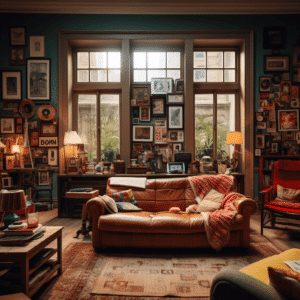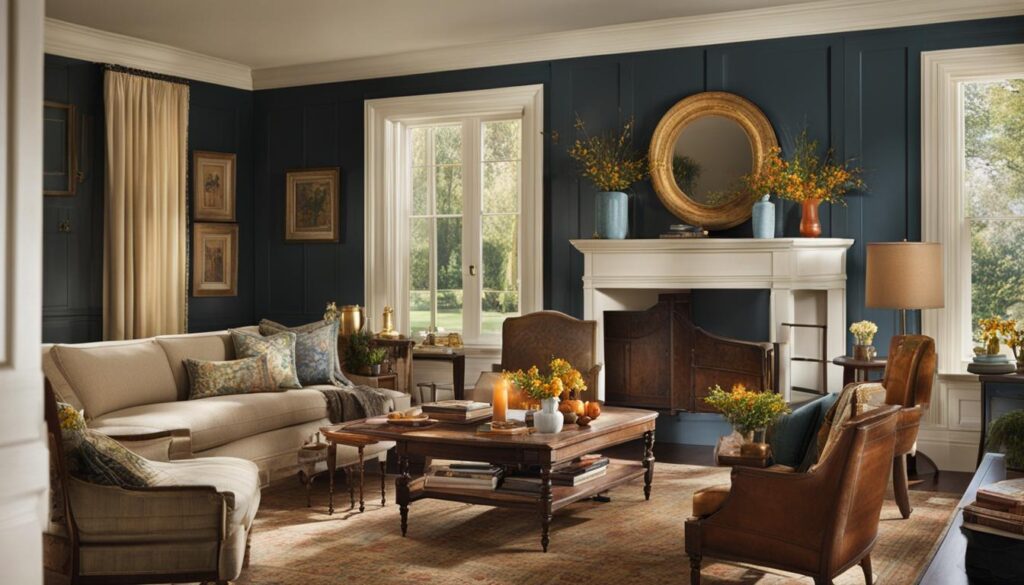Have you ever wondered why it’s called a living room? The name “living room” has an interesting history and cultural significance. Let’s explore the origin and evolution of this beloved space in our homes.
Table of Contents
Key Takeaways:
- The term “living room” emerged in the early 20th century as a replacement for “parlor” or “drawing room” used in the Victorian era.
- Edward Bok, an influential figure, advocated for the name change to encourage a more comfortable and welcoming space for daily activities.
- The Ladies Home Journal came up with the name “living room” to show that things were becoming more happy and social after World War I.
- Over time, the living room has evolved into a versatile area for relaxation, entertainment, and family activities.
- The difference between a living room and a family room lies in their intended use, with the former being more formal and for entertaining guests, while the latter is a casual space for family interactions.

The Evolution of the Living Room
The wealthy embraced living rooms in the late 19th and early 20th centuries.People went there to relax and have fun. Fancy rooms like parlors were only used for entertaining guests before that, and rarely used rooms were termed “death rooms” during the pandemic. After the epidemic, the word “living room” was used to move over the melancholy and create a more entertaining and social home.
Living rooms have changed with time and society to reflect different cultures and lifestyles. Large living rooms with comfy furniture were symbols of suburban life in the mid-20th century. Families watched TV, listened to music, and relaxed there. This shifted living spaces to be more relaxed.
The living room continues to evolve to fit modern homeowners’ needs. Socializing, entertainment, and family time have taken over. Open-concept designs that combine the living room with the kitchen and dining area and smart home technologies have made the living room a versatile place that meets the needs of people and families.
The Changing Design Trends
Over the years, there have been notable design trends in the evolution of living rooms. In the mid-20th century, popular styles included mid-century modern and minimalist designs, characterized by clean lines, simplicity, and functionality. In recent years, there has been a resurgence of retro and vintage-inspired designs, as well as a focus on creating cozy and inviting spaces with elements such as warm colors, textured fabrics, and natural materials.
Furthermore, the concept of the living room has expanded beyond the traditional four walls of a house. Outdoor living spaces, such as patio areas and decks, have become an extension of the indoor living room, blurring the boundaries between indoor and outdoor entertainment and relaxation.
The Future of the Living Room
As technology continues to advance and shape our daily lives, the living room is expected to undergo further transformations. With the rise of smart home technology, homeowners can now control various aspects of their living rooms, from lighting and temperature to entertainment systems, with just a few taps on their smartphones. Additionally, eco-friendly and sustainable design practices are becoming more prevalent, leading to the integration of energy-efficient appliances and materials in living room designs.
While the fundamental purpose of the living room remains the same, its evolution reflects the changing values, lifestyles, and design trends of each era. It is a space that adapts to meet the needs of individuals and families, providing a comfortable and inviting environment for relaxation, entertainment, and socializing.

| Decades | Design Trends |
|---|---|
| 1950s-1960s | Mid-century modern |
| 1970s-1980s | Minimalist |
| 1990s-2000s | Eclectic |
| 2010s-present | Retro, cozy, and sustainable |
The Difference Between Living Rooms and Family Rooms
There is often confusion about the difference between a living rooms and a family rooms. While both serve as spaces for relaxation and gathering, there are some subtle distinctions.
In many homes, the living room is still utilized for entertainment and may be more formal and near the entry. Homeowners can impress guests there. In contrast, the family room is a more relaxed environment where family members can relax, play games, and watch TV. It is usually remote from the main entrance and practical rather than formal.
Some homes have a family room and a living room for distinct purposes. The living room hosts guests and showcases the homeowner’s flair, while the family room is suitable for family use. Not many homes have both rooms, and “living room” and “family room” are commonly used interchangeably.
The homeowner’s lifestyle and tastes determine how to use these areas. Each area, whether a living room, family room, or combination of the two, can be customized to welcome visitors and family.
FAQ
Why is it called a living room?
What is the history behind the living rooms name?
The name “living room” was suggested in an issue of the Ladies Home Journal, which aimed to move past the sadness of the post-World War I period and embrace a more joyful and social atmosphere. Over time, the living rooms has evolved to become a versatile space for relaxation, entertainment, and family activities.
How did the living rooms evolve?
Wealthy people liked living rooms in the late 19th and early 20th centuries. It sought comfort, relaxation, and leisure.In the past, parlors entertained guests, and during flu episodes, rarely utilized rooms were termed “death rooms.” People used “living rooms” to get over their melancholy and make their homes more cheerful and hospitable following the spread. People can customize their living rooms for mingling, visiting, and family time today.
What is the difference between a living rooms and a family rooms?
Both are relaxing and gathering locations, albeit with small variances. Some homes still entertain in the traditional living rooms at the entry. The family room is a more casual space where family members can play games and watch TV. Practical rather than formal, it is frequently far from the main entrance. Some homes use “living rooms” and “family rooms” interchangeably. Their utilization depends on the homeowner’s lifestyle and tastes.


